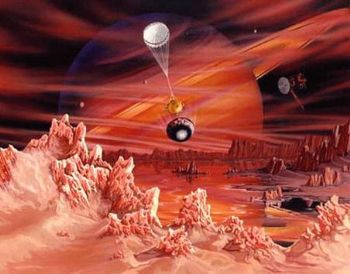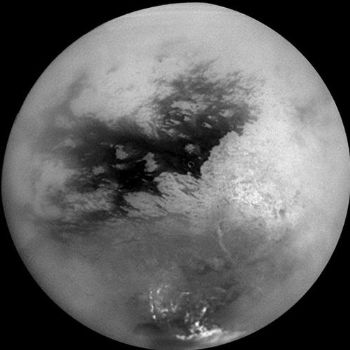by Larry
April, 2005The Time (and Space) MachineThere is an anecdote in the book, Zen and the Art of Archery, by Eugen Herrigel, about a teacher who, to demonstrate the kind of detachment necessary for proper archery technique, shoots an arrow a long distance toward a target obscured in darkness. When the student views the result, he is astonished to find that the arrow has pierced the bull's-eye. He thinks this must have just been a fantastically lucky shot until his teacher, repeating the earlier conditions, but this time not even looking downrange, tautens the bow and releases a second projectile. It splits the shaft of the first arrow and so plunges into the target at essentially the same point. On January 14th of this year, a similarly amazing feat was accomplished, through the multi-year cooperative efforts of the National Aeronautical and Space Agency (NASA), the European Space Agency (ESA), and the Italian Space Agency (ASI), when a robot probe, Huygens, culminating the Cassini-Huygens space journey, a mission of over 2 billion miles, landed on Titan and sent back 350 images along with other important data about Saturn's largest moon. Considering the difficulties between the US and Europe recently, many may regard any complex joint effort a remarkable attainment.
Humans rightly see the first steps by one of our kind on Luna, Earth's large, planet-like moon, as a significant event in our species' advancement. Some think robots will one day become so sophisticated and intelligent that they will acquire self-awareness, consciousness. Notwithstanding Isaac Asimov, I have my doubts, but if that achievement is ever attained by a form of cyber-beings associated with us, they surely will look back with a robot equivalent of satisfaction on the early accomplishments of their Cassini-Huygens predecessors in this completely unmanned Saturn-Titan exploration. Better than "HAL," more like "R2D2," both the huge Cassini craft and the small Huygens probe really came through when the chips were down! As I write, Cassini is still going strong, recently having made new orbit passes and taken additional clear composite pictures of Titan. Like the situation in the Zen archery example, Titan, roughly a billion miles farther from the sun than Earth, is essentially in darkness. The temperature on that moon's surface is -291°F. It is so cold there that water is as hard as rock and makes up a portion of the landscape much as stones do here. Scientists puzzling over our planet's remote past yearned for a practical means of studying conditions when this orb was still young, back when life here was just getting started and methane apparently was the most dramatic element in the early environment. At 600 times our current air's methane levels, it ruled Earth's climate, dominated the atmosphere with reddish-orange hazes, and rendered the sky an alien red instead of blue. Methane producing anaerobic bacteria, or methanogens, are believed to have been responsible for the large accumulation of methane in early Earth's atmosphere. The eventually huge concentrations of methane, in turn, would have better captured and held the sun's heat, necessary for the planet to avoid an intense deep freeze effect for long periods and to so promote the spread and evolution of life, since the sun gave off much less energy and warmth than now. However, while the high concentrations of methane in the lower atmosphere aided that period's version of global warming, high atmosphere methane hazes would have reflected some of the sun's heat back into space, thus preventing a runaway greenhouse effect such as Venus seems to have had. (Incidentally, researchers think a possible presence in smaller quantities of methane in the current Martian atmosphere may indicate subsurface methanogens are living there now, as is true within Earth today as well.) It is thought that the climate likely marched to the tune of the methane drummer until other organisms began producing large quantities of oxygen, which was substantially responsible for transforming of both Earth's atmosphere and the biosphere to that which we have today. But scientists, of course, could not just go back and examine early Earth's circumstances, to confirm and refine such hypotheses. Without more information, much about the beginnings of this "Third Rock from the Sun" would have to remain speculative. They needed a time machine. Enter Huygens. There are big differences between the two worlds, Titan today and Earth 2-3 billion years ago, but the combined craft, Cassini-Huygens, traveling about a mile in space for each year back in Earth's prehistory required to investigate Terra's ancient methane world, has provided the first practical glimpse into the reality of a methane environment, one in a few key ways similar to what apparently prevailed for at least hundreds of millions of years in Earth's distant past. Both old Terra and modern Titan shared upper atmospheric methane hazes and high concentrations of methane in the lower atmosphere. Also, the data from Titan will help scientists learn more about the chemical relationships that must have prevailed on our planet 2-3 billion years ago. The spheres' atmospheric chemistries may indeed be or have been much the same.
The complexity of the mission was awesome. That most aspects of the endeavor went flawlessly seems phenomenal. Cassini-Huygens was launched in 1997. Several years of preparation prior to that had been required. Its complicated, 7+ year journey involved four passes near planets to give it gravity assists (one swing by earth following launch, two around Venus, and one, powerfully boosting Jupiter flyby). Early in July, 2004, Cassini then made a close approach to Saturn, taking abundant pictures, and went between the planet's F and G rings before configuring itself in reverse and firing its engine, thus establishing an eliptical orbit about the giant gaseous orb. A number of later engine burns prepared Cassini-Huygens for the orbit about Saturn's large moon, from which the Huygens probe, on 12/24/04, separated from Cassini and began a three-week solo flight closer to Titan before, on 1/14/05, starting its drop through the thick Titan atmosphere (roughly ten times as high as Earth's). A heat shield shaped like a saucer protected the small craft as it drifted and fell. Three parachutes (pilot, main, and drogue) were deployed to lower the probe's speed while it dropped. Before the last of these opened, the heat shield was jettisoned. One thing the engineers and scientists had not counted on was the intense buffeting the probe would receive from Titan's powerful air currents. At one point, Huygens was being pushed by winds of about 270 MPH. The landing of the probe was surprisingly soft. It penetrated about six inches into a muddy surface. The probe's own heat may have partially melted the landing site, cushioning the 10 MPH final speed of the descent. In consistency, the landing area was like moist clay mixed with sand. There was at that point also a burst of methane gas around the craft, perhaps due to hydrocarbon ice rocks having liquefied and partly boiled off. Here are some of the preliminary results primarily from the Huygens probe, besides voluminous added info provided by Cassini about Jupiter, Saturn, its many rings, Titan, and Saturn's other moons:
The findings mentioned were mainly gleaned from only the first week after Huygens had landed on Titan and begun sending back pictures. As the reams of additional information from the probe are analyzed and their findings coupled with the hundreds of images, much more will be known in the years ahead, not merely about Titan, in 2005, but also perhaps about the solar system's third planet, over 2 billion years ago.
Saturn At Last. J. Lunine in Scientific American, Vol. 290, No. 6, pages 56-63; June, 2004. Titan Touchdown. R. Talcott in Astronomy, Vol. 33, No. 4, pages 36-41; April, 2005. When Methane Made Climate. J. Kasting in Scientific American, Vol. 291, No. 1, pages 78-85; July, 2004. |


